
David Alfaro Siqueiros was born in 1896 and died in 1974. He was one of three, who were considered the three masters of the Mexican School of mural painting. He was born in Chihuahua, Mexico. He was a sergant for the Mexican Revolution and a colonel for the Spanish Civil War. He was jailed numerous times for his political activism, and resulting from this, he created his works. He was the first artist to use acrylics for painting.
I chose the Untitled, Niño en negro. It is a painting that is going for over $60,000 at this moment.It is a Pyroxiline and oil on board mounted on a masonite, and it was painted in 1962 at his stay in the Lecumberri prison. This painting was the his seventh incarceration for his political acts. This painting is only painted with black and white color making me think it was actually trying to stress a message. It could stress the social injustice and racial discrimination of the past, and the consequences of such things. Some artists feel that that color is an “evocative evocative of Picasso’s 1937 dramatic masterpiece, Guérnica, (also painted in a palette devoid of color) and its denouncement of fascism and war.” This piece is based on religion and Jesus. Also, it expresses humanity’s hope. This is seen through the child. He never had any son’s, but he loved his two loves children like they were his own. These two loves were Angelica Arenal and Blanca Luz Brum. He adopted Angelica Arenal’s daughter, and he was close to his grandson named Davidcito. Davidcito is the child in the painting.
I was fascinated by this picture when I saw it in the collection of Mexican Art. There was very little to go on for this painting, but when I looked at the picture all I could think of was my child. It was like the child in this painting was suppose to take your breath away. The shading of the painting and strokes on the little boy make the picture really stand out on the ground. I liked this painting mostly because the way he brought up the racial discrimination problems. This painting has so much meaning behind it that is unclear. Everything about this painting screams discrimination, yet he uses his grandson. I found that oddly particular. I wish there was more information on this painting. All that I could find was that he couldn’t conceive so, he adopted and then fell in love with his grandson. He uses his grandson in a variety of his painting, and they all have a religious undertone. What comes to your mind when you see this painting? Do you see racism? Or do you see, a naked little boy and see how precious life is? This painting confuses me. This is only because there isn’t a whole lot of anything to go off of. That is what truly fascinates me.
Mexican Art
November 29, 2009Genocide
November 21, 2009
The work I chose is rather extraordinary. It is called, Genocide Monument, and it is to show people what went on during the 1994 Genocide in Rwanda. It was created by a man named Kofi Setordji. Kofi was born in Accra in 1957. He started out in the early 1990s, and he progressed into a full-time sculptor by the late 90’s. In 1990, he received sculptor of the year award. Wisdom Kudowor and Kofi founded the Society for Contemporary Art in Ghana. He has artwork all over Africa, Europe, and the U.S. Parts of this monument has been shown in the Ivory Coast, Senegal, and France. Now, there is talk that it could move to tour Germany.
He created this piece after seeing thousands of bodies being pushed aside with bulldozers because they were nothing more than scraps. He felt the world needed to see and understand what happened in Rwanda. The piece consists of 300 pieces. It never says exactly where it is now, and when it was made. However, there was a documentary done of Kofi during his creating of this monument, and it was made in 1992. Its directness it toward the viewers conscience and what they make of it. This is a continuous project, but was “completed” after 2 1/2 years, and weighs more than a ton. “According to him he could have carried out the clay work, the casting, chiselling, burning and hammering in a five-month period, he needed the time to allow the project to develop emotionally.” His work is suppose to fully give his emotions, and it is suppose to ask the “unspoken question” of how can people consider themselves civilized if they intentionally killed these people. More than 800,000 lives were lost during this genocide. No action had been taken, even with everyone knowing that a mass murder was going to take place. The parts of the monument include:First Victim, Vulture, Sentrypostmen, Fragments of Evidence, Direct Victims, All Seeing Eye, Statue of Justice, The Call for Justice, War tribunal, Passive Watchers, Burnt Victims, Menace, Indirect Victims, Masqueraders, Musicians, Mass grave, and Group.
First Victim is suppose to represent when you wake up and you see a dead body. The vulture is the bird that flies over the corpses so, you know a mass murder has occurred. The Sentrypostmen were the victims that just disappeared without their own grave, but they were thrown into a pile. The fragments of evidence is what he incorporates in the faces of his monument, human flesh. Its suppose to represent how far people will go to find something about the genocide and that it really occurred. The direct victims is apparent. The people that were killed. The all seeing eye was the broadcasting stations that viewed his and how nobody did anything about it, as they watched bodies float down the Kagera River. Statue of Justice and The Call for Justice; How much more prove do you need than that? Passive Watchers were people that just watched this happen and did nothing while, the burnt victims were looked at by these people. Menace was the thought of how would you feel if this happened to you? Indirect Victims were the people who died as a consequence of the genocide. Masqueraders were the politicians and military who lead them to death. Musicians were suppose to represent that human spirit cannot be lost. The mass grave was the lost bodies. And, the group was the thought that genocide occurs “when people try to destroy, whole or partly, a national, ethnic, racial or religious group.”
I chose this piece because it really makes me think. I have studied the genocide. The pictures are horrible. Genocide is defined as genocide means “any of the following acts committed with intent to destroy, in whole or in part, a national, ethnical, racial or religious group, as such:Killing members of the group; Causing serious bodily or mental harm to members of the group;Deliberately inflicting on the group conditions of life calculated to bring about its physical destruction in whole or in part; Imposing measures intended to prevent births within the group;and/or Forcibly transferring children of the group to another group.
I chose this piece because it has such a deep meaning to it. I was horrified by the monument, but then again that was his intention. It was for the viewers to understand that the genocide was a horrible thing, and that it shouldn’t have happened or been taken lightly. What really intrigued me was that the faces in this peice have actual pieces of human flesh in them! Do you think that this is a murderous way of thinking? Creepy? Or, do you think he did this solely to give the viewer a deeper meaning to his sculptor?
Source:
http://www.vmcaa.nl/genocide/engels/documentaire/index.html
Feminism
November 14, 2009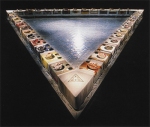
Judy Chicago, the creator of The Dinner Party has been creating work for over four decades. Her earlier works are influenced by the rise of the minimalism. Her most famous work is, The Dinner Party . She was born in Chicago in 1939, and she attended UCLA art school. She graduated in 1962, and then she earned her MA in painting and sculpture. She founded the first Feminist Art program. In October of 1970, she changed her last name, and she was quoted in a town newspaper saying that she changed it to rid herself of male social dominance. In 1971, Chicago and Miriam Schapiro together founded the CalArts Feminist Art Program for the California Institute of the Arts. Also, together they made the first feminist art exhibitions called Womanhouse. And, then in 1973 she help found the Feminist Studio Workshop. This was a feminist art teaching and exhibition spot.
The Dinner Party was created between 1974 and 1979. This piece travels the globe. It symbolizes women of the Western Civilization. The point of its creating was to “elevate” women’s achievements that was typically suppose to be for men. The piece is a ceremonial banquet that is on a triangular shaped table measuring 48 ft on every side. It is larger than a life size table, and it set for “guests of honor.” All 39 plates set have an image relating to the butterfly. The butterfly is symbolic “of a vaginal central core.” Each butterfly relating to each woman’s story. This work made me feel like the achievements of these women were derectly related to the kitchen. However, I also feel as though the thought of an elegant table set is the typical thing I would think of as a woman. Tea parties, dinner, and the kitchen all relate to the sterotypical woman.
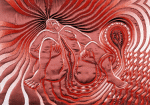
The Birth Project also was created by Judy Chicago. This art was created between 1980 and 1985. Before the creation of this work, there weren’t many pictures or art on birth in Western Art. Birth is a central focus on woman. They bear their children, and they are the loving and caring ones. This is how everyone on earth is brought here. It is amazing how there really wasn’t something recorded or created when you see it everyday. Her creations in this piece were through needlework. This series of needlework pieces are all of woman and child bearing. Birth is the identity of a woman. The creation of this work was actually through stories and experiences of other woman. This series consists more than 80 units. They range from very small works to works as large as 20 feet. I was very interested in this piece. The art work she used in this truely resembles what birth is really like. It is not all grand like men make it out to be. Birth is gross, bloody, sweaty, and it is labor. That is why it is call labor.

Resolutions: A Stitch in Time is created by Judy as well. This is also a series of needlework. It was created in 1994. It has 19 images and one sculpture. There are many technicues used such as embroidery, applique, quilting, beading, macrame, smocking, needlework, and petitpoint. Her needlework for these peices are to focus on the hard work of women in their homes. There is not too much information on this piece. I found these pieces intiguing. She uses the hard work and labor of women. I see in these stitchings that women teach their family how to go into the real world with tolerance and respect, and from their they teach humility and use that in their ways in life. I feel the words build on each other, starting with family.

International Quilting Bee is also created by Judy Chicago, but was also created by 700 women and their organizations. It is suppose to bring out womankind and their accomplishments, pesonalities, and their own indiviualism throughout the world. “Some are memorials to loved or admired individuals; others are testaments to the impact of The Dinner Party on the quilters themselves; still others depict the impact of formal women’s groups, businesses, or organizations on the quilter.” This work doesn’t have too much on it, but what it does have makes me strongly feel that this was created to help share that women have a place in this world, and they should be rewarded for their work too. They should not have to stay in the sterotypical way of women and stay in the kitchen.

Nancy Spero, the creator of We are Pro Choice feminist activism. Her artwork is influenced by the Vietnam War, the Civil Rights movement, and the women’s movement. She was born in 1926 in Ohio. She graduated in 1949 from the Art Institute of Chicago, and she studied painting in Paris. Some time between 1959 and 1964 she has her first solo exhibitions which included her “Black Paintings.” Her later works were more toward the violence toward women. “Coupled with her growing feminist perspective in art form, she also became more aware of the absence of women’s art in a culturally male defined art world.” Her art work shifted toward the struggle of women everywhere, and in doing this she realized the continuous resistance toward such artwork in the U.S. In 1972, she became a co-founder of Art of Residence, as well. Her work was geared toward a different view, not commonly seeing, was the woman’s way of seeing as woman instead of the male version of a woman.
We are ProChoice as created in 1992. Since Spero is an American Jew, she focused alot on Jewish women. This is seeing in this work in which the bodies and spirits of these women were violated during Nazi Germany. This work was to be the voices of these broken, tortured, and “disappeared” women in the male dominate Latin America. Still, she gives the women freedom and expansiveness. “Nancy Spero has said, “Even when the work is celebratory, I still hope it has subversion to it, in that all the protagonists are women. Spero’s work is featured in many galleries including the Whitney Museum, the Jewish Museum, and the Studio Museum in Harlem and at the NYC MOMA.

Miriam Schapiro, the creator if Kimono created in 1976, is a Canadian-American. Her work was geared toward feminism. She was apart of the Pattern and Decoration art movement. She was born in Toronto, Canada, and she went to college at the University of Iowa. She married in 1946 to Paul Brach. The moved to New York City between the 50s and 60s. Shapiro was an abstract expressionist painter in the hard-edge style. In the 1970s, they moved to California. She helped establish the Feminist Art Program at the California Institute of the Arts with Judy Chicago. Also, she helped with the Womanhouse in 1972. Her work in the 1970s was more of collages and fabrics that include “femmages”.
“Flowers of all sorts are prominent in this collage; the large chrysanthemums in the center link the floral dresses of America to the costumes of Asia – east meets west.” This painting represents identity. “Kimono represents an identity. In the Western world, the kimono tends to be associated with submission, fragility, and femininity. In the Eastern world, however, the kimono was worn by both men and women. Schapiro’s kimono, with its bold colors and large surface area, does not look delicate, passive, or quiet. The dramatic patterns and widened obi block out the kimono’s symmetrical surface and meaning, suggesting a new symbolic status.” There is really nothing really about this painting. The Kimono was created in 1976, and it is a collage and acrylic on canvas. I quoted what she explained the painting to be because there was no better way of explaining it. I found this painting very interesting. I loved how she took the representation of both the western and the eastern worlds, and then she combined them in one!
Influence of African Americans
November 2, 2009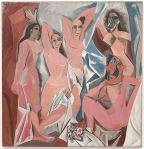
I chose the oil painting, Les Demoiselles d’Avignon (The Young Ladies of Avignon) by Pablo Picasso. It was created during the summer of 1907, and it can now be found in the Museum of Modern Art in New York City. The painting is of five unclothed prostitutes from a whorehouse on Avinyó Street in Barcelona. Each of the women are altered in a way that makes them not look feminine. They all possess an angular figure. All of the woman look savage like, and two of the five women have African face masks on. Picasso abandons the favored look of color and light-defined forms of Impressionism and the Fauves, to a flat, more angular, and more about the lines. He was going for more of a two-dimensional look completely going against the traditional European style. Picasso is credited with the development of Cubism.
This piece was sketched over one hundred different times. At he beginning, there were two men in the sketching, and one, a medical student, was holding a skull. Some interpret this as “a wage of sins are death.” Picasso felt that the more people mankind produced the more we became corrupt. Hense, the prosistutes and this was also a time when the whites and other ethnicities such as the African Americans were not considered “human and on the white people’s level.” Sad, but true. However, Picasso denies that
Demoiselles was influenced by African tribal masks and the art of Oceania. Art historians are skeptical of this, but at least they think if this isn’t true, that when he went the spring before it was created, that his visit to the Musée d’Ethnographie du Trocadéro that his painting was unconsciously influenced by African and Tribal art he saw there. Then, there are other critics that argue the painting was a reaction to Henri Matisse’s Le bonheur de vivre and Blue Nude.
Nobody actually knows the real meaning behind this paining. This is what fascinates me the most. I like the way he twists the perception of how humankind is perceived. I like how he combines the altered savagelike subjects with the dark messy colors. It actually reminds me of Africa. I feel that his work was influenced by his visit to Musée d’Ethnographie du Trocadéro by not subconsciously. I think his connection of African Americans and his work was strictly subconsciously, however the way he lived his life was numerous wifes and mistresses among all of them, had to have played a role in his work. He truly believed mankind has grown horrible and sinful since the beginning of time, was he talking about himself?
Impression on Impressionism
October 24, 2009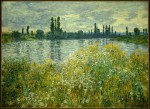
I absolutely love Impressionism. I chose an oil painting to share called Banks of the Seine, Vétheuil by a French painter, Claude Monet, and it was created in 1865. The painting can now be found at The Chester Dale Bequest, National Gallery of Art in Washington, D.C. This piece captures a moment in which the light is shining on the grass , trees and water. The color is sublime and it makes you feel as you are part of the scene. Monet’s goal was to capture “fleeting” effects of light and the atmosphere. Within this painting the brushstrokes vary depending on what texture he was trying to portray. This can be seen in the “horizontal skips in the river’s gently rippled surface with the rounder, swirling forms of the sky.” This is the forground for what is suppose to be drawing more of our focus to, the thick and lush grass and flowers. These are painted with lots of crowded and colorful strokes. These strokes can be assumed to have an importance of its own from being decorative in the painting to being descriptive as well. In saying this, later in his life he suffered severely of cataracts where he had visions, and can be shown through his paintings with his vivid colors and brushstrokes. His paintings changed from red to blue toned as they were removed.
Impressionist paintings included characteristics of “visible brush strokes, open composition, emphasis on light in its changing qualities, ordinary subject matter, the inclusion of movement as a crucial element of human perception and experience, and unusual visual angles (http://en.wikipedia.org/wiki/Impressionism). What fascinates me the most is emphasis on light. Many painters during this time created the same work repeatedly just a different time of day or season. This can be seen in his series of paintings called Rouen Cathedral, West Façade, Sunlight and Rouen Cathedral, West Façade.
I like how he gave a soft edge to his work. This “softness” can be found among all the paintings of this time during Impressionism. Everything looks to be rounded off to make the picture less “straight to the point,” in other words with angles. The lack of angles gives the picture not only a soft touch, but it also give a peaceful tone as well. Also, all of his paintings are harder to tell what they are until you are further away, and then the picture is presented.
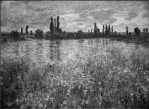

These two paintings were created in 1892 by Monet as well and are called Rouen Cathedral, West Façade, Sunlight and Rouen Cathedral, West Façade. Monet rented a room across the from the Rouen cathedral. He stayed in this room from January to late Spring, and he painted this picture repeatedly to capture different times of day, seasons, and light. Then the following winter he came back, and his explanation was this,“To me the motif itself is an insignificant factor,” Monet
said. “What I want to reproduce is what exists between the
motif and me.”
What Motet aimed for by the end of his lifetime was no longer to record his “sensory experience,” but to explore
light and color more and
working on the cathedral series, “more serious qualities, that
one might live longer with one of these canvases. This is why I am so fascinated by the use of light. This series is one of many he has painted over his lifetime, however all of them can be connected with one characteristic, light. I focus more on light because that is what I light most about his paintings however, his paintings are intersting to say the least because not only does he explore as a painter, but he also rounds of his work with a soft touch, yet he manages to add lots of colors. These colors are thicker in some areas and thinner in others to give a more of a overall look rather than broken apart.
Impressionism is unlike any of the other works we have covered in class. It is not abrupt in its edges or it is not careful detailed like that of the Renassiance. Impressionism is more flowing, fuzzy, and easy going where as Baroque was boring to me. It was like a still photograph in which dark colors could be used to give a dark and gloomy feeling. The paintings we studied before this section never actually made the audience take a step back and truly look into what the painting was trying to relay. This could be by emotions, color, religious background, you name it. The most interesting part of this era is truly the lack of dramatic details. The paintings by Monet are truly stunning, and bring a whole new meaning and outlook on oil paintings.
Courtney’s Blog :)
October 14, 2009The piece of work I chose for this blog is called, No. 39 in G major by Hoboken 15/25 “Gypsy” by an Austrian composer, Fran Joseph Haydn. He is known as the “Father of the Symphony,” and “instrumental in the development of the piano trio and in the evolution of sonata form.”
Haydn’s life growing up was very basic. His dad worked as a “Marktrichter,” and his mom worked as a cook. His family was far from being wealthy. He was always hungry with the little food his family could afford, and his family’s lack of money was apparent with his shabby clothes. This didn’t stop him from getting practice and experience anywhere he could. As he got older, his voice matured and at one point he loses his job. This is his first push to becoming a freelancer musician. And, from here he took on several jobs as a music teacher, as a street serenader, and as valet–accompanist for the Italian composer Nicola Porpora. This was the start to his rise from middle class.
This particular piece was one of his later works and introduced in 1795. Haydn’s G Major 15/25 is considered the most popular of all of his works. He is best known for his trios with a cello, violin, and a piano. In this trio, it has three movements. The first movement is a series of variations. In most all of them, there are repeating sections and a main theme played by the violin. The violin is often played in conjunction with the piano. Following, the main theme is then altered and manipulated with a few minor-key “excursions.” This is where the composer makes the excitement in their music, but still relating its audience back to the original theme. This makes the piece a song rather than a bunch of jumbled notes.
The majority of Hadyn’s work is dominated by the piano. The violin plays the melody, and most often than not it is doubled with the piano when doing so. While, the cello plays the bass line of the piano. His music was created in this way because back in his day the violin was the “weak” sounding one and benefited from the booming tones of the piano and cello combined. His later trios such as this one, were more of an appeal to the public say than his earlier works because as a composer he hadn’t reached full maturity and had enough experience as an composer to create a much “fuller” sound.
This particular composed work stuck out to me because my Great Grandmother played this with two of her friends when I was first choosing a instrument I wanted to learn how to play. I love the melody line and how the music gets exciting toward the middle and then resolves at the end! 🙂
Courtney’s Ramblings :)
October 3, 2009
The piece I chose is called, The Fortune Teller by Georges de La Tour. The painting is an oil painting created in 1630. The work was discovered in 1960, and was immediately bought by the Metropolitan Museum of Art in New York City. The painting has been questioned in the past as to who actually created the painting. However, it is widely accepted as Georges da La Tour. La Tour is more commonly known for his religious works in which the people have a “single light source” and do not have the fancy detailed costumes as presented within The Fortune Teller.
The painting presents an event in which a man of wealth is giving a coin to a teller to receive his fortune. She takes the money within the painting for two reasons. One, she took the coin for payment. Two, She took it as a ritual in which the teller holds hands with the one requesting the service. The women presented in the painting is a gypsie, woman looked upon as thieves. The man is so into everything thee woman is saying he doesn’t realize she is stealing his money with a friend stands behind him ready to help her. The girl to the left is not a gypsie, but she is directly involved.
The painting never made it to Louver, the largest museum in France, due to the art historian, Germain Bazin, who had serious doubts about the piece.
George de La Tour’s work was directly influenced by his home life. He was the second child born to Jean de La Tour and Sybille de La Tour. Sybille was from a partly noble family. His schooling is still to this day unclear. He is thought to have gone to Utrecht School. He married Diane Le Nerf who was from a minor noble family. A few years later he established his own studio, and eventually was given the nickname, “Painter to the King.” His main influences in her art were of Caravaggio in his early works then gradually worked its way into the works of Gerrit van Honthorst. In the last few years of his life, he moved into painting mainly religious subjects.
I found La Tour’s, The Fortune Teller unique. When I first saw this piece, I thought the naive youth being robbed was trying to share the rise of the merchant class. Basically I saw this because the money the young man has in his pocket was probably hard earned money whether from him or his family. However, the gypsy girl’s rob him of his hard earned money making them cheats. This made me think it was the rise of the merchant class until I found his influences of his royalty.
This painting is full of color, and the amount of meaning behind it is incredible. The lighting in the picture fascinates me because it sheds light on the gypsies and the girl that looks like she is involved in the pick-pocketing isn’t in the light as if to represent that she is not one of “them”.
Courtney’s Blog
September 23, 2009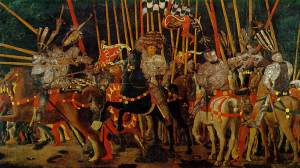
The painting, Battle of San Romano, presented was created by a man by the name of Paolo Di Dono however, he was commonly known as Uccello. These paintings were created in 1432. The painting consists of three wooden panels all of which are three metres long, and they show some of the events that occured at the Battle of San Romano. The three paintings are as followed Niccolò Mauruzi da Tolentino, Galleria degli Uffizi, and Musée du Louvre.
The Uffizi was intended to be the middle painting, or so people think it was suppose to be. It is the only painting Uccello signed. Nobody actually knows the correct order for sure of the three paintings. However, the most common sequence is London, Uffizi, and Louvre. The battle lasted a total of eight hours, and the paintings are perceived as being the three stages of the day; morning, mid-day, and night. The London painting is thought to be how someone would perceive the battle from the outside with dead soldier’s lined up.
The paintings had gold and silver leaf. The gold has remained a bright as when it was created while, the silver has faded to a dull grey color. All of the paintings have suffered from time and restoration.
The Battle of San Romano was commissioned by Leonardo Bartolini Salimbeni, but after he died Lorenzo de’ Medici moved them to the Palazzo Medici. Not only did these paintings make Lorenzo happy, but the painting meant so much more than their pleasure. It represented the power of the Medici family in Florentine finance and politics. These paintings remained in the Medici family until the late 17th century, almost three hundred years.
Paolo Uccello’s work is interesting because all of his paintings were done on perspective to provided depth in his work. Also, he did not use the Classical realism ways of creating a painting. He stuck with the Late Gothic tradition, and he can be best described as “idiosyncratic” (http://en.wikipedia.org/wiki/Paolo_Uccello).
Courtney’s Ramblings
September 23, 2009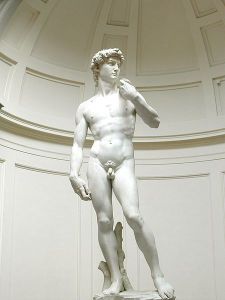
The Statue of David was a sculpture created by Michelangelodi Lodovico Buonarroti Simoni during the Renaissance between 1501 and 1504. It is seventeen foot naked statue of King David made out of Carrara Marble, and was located in Galleria dell’Accademia, Florence. The original was replaced with a replica. Now, David is at the Accademia Gallery in Florence. The statue represents the “defence of civil liberties embodied in the Florentine Republic.” These civil liberties included the Medici family.
Michelangelo believed that sculptures were the closest thing to divine creation. David was is both a symbol of youth and beauty. The hand and upper body are larger than the lower body. The body is disproportionate due to the fact it was suppose to be put into a church in which one would have to look up to it, creating an illusion. Also, the statue has the toes on its left foot completely smashed after a man attacked it with a hammer.
Michelangelo’s career started as early as his teens. He was one of the first students to ever attend Lorenzo Medici’s art school. The Medici family took him under their wing and helped shape his career as an artist. He was introduced to the greatest artists of their time, parties, and debates. This helped to shape his life long career.
After the death of his Lorenzo, he went into hiding. However, when he was in his mid twenties he went back to Florence where after years of trying to out his rival, Leonardo De Vinci, the Statue of David was introduced. The statue became a “symbol of the city” (http://www.pbs.org/empires/medici/renaissance/michelangelo.html). When Giovanni de’Medici noticed this and was made Pope Leo X he offered Michelangelo a task at making huge tombs for his father and brother. He could not refuse such a request from the Pope.
I chose this piece after watching an episode on the history channel about the Statue of David. I found it interesting the entire statue was created by three picks, and the marble on it can erode alot faster than most marbles. What fascinated me the most was the ability Michelangelo had to create something of its size in just a few years is astounding. The artwork is beautiful, and the beauty of the status reminds me of Adam and Eve and their power of strength.
Courtney’s Ramblings
September 8, 2009
Hi all! Let me start by saying, I am the worst blogger. I am currently on my sixth attempt at getting this down. So, everyone please bare with me. I look forward to reading everyone’s blogs. I hope you like my rambling as much as I will enjoy commenting yours. I look forward to meeting all of my fellow classmates.